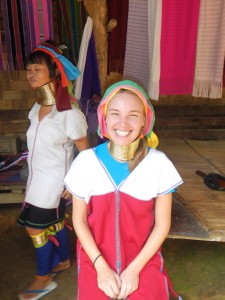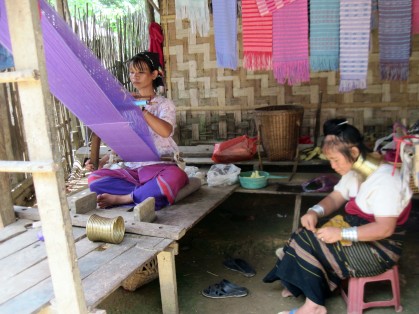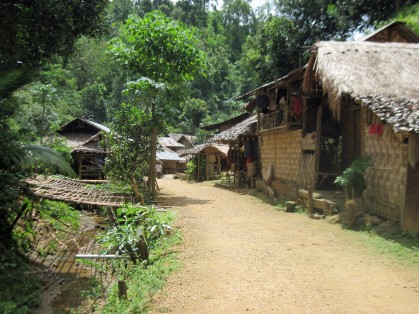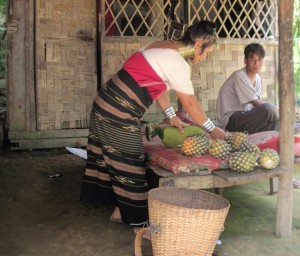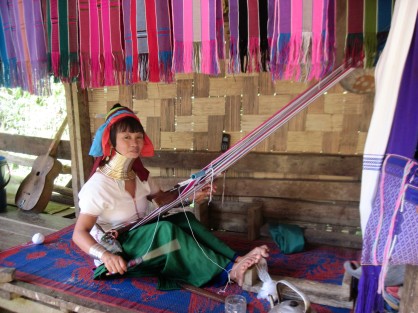Within seconds, my collarbone started burning from the weight of the metal necklace. 8 rings, fused together into a decorative cuff, pushed my chin up. Swallowing took effort.
“Hurry up, please, this is slightly uncomfortable,” I stage-whispered to my boyfriend.
Smiling for the flash, I felt like an insensitive tourist. The Padaung, a culturally distinct group within the Karen peoples of Burma and Thailand, wore the cumbersome metal necklaces from childhood to death.
And mine were merely a tie-on prop.
Like most Western travelers, I watched in awe as these long-necked women – often referred to as a “giraffe tribe” – carefully went about their daily tasks. Several sat on elevated wooden platforms and wove bright yarns into patterned scarves for sale. One slowly wound kelly green string into a giant spool. Another bounced a topless baby on her hip.
While the 50 households in Ban Nai Soi, northern Thailand, grow pineapples and fruits, or hire out to surrounding farms as laborers, their existence is directly tied to the tourism industry. Many families earn a steady income from selling handicrafts to travelers who visit the village.
However, as refugees from Burma, the luxury of living outside the nearby refugee camp – where many of their Burmese compatriots are held – is dependent on their popularity among curious sightseers. Ban Nai Soi was built 15-20 years ago, when Thai officials recognized the benefits of drawing travelers to the area with images of elongated necks and exotic costumes.
Inside Burma, the Padaung women’s zoo-like affect is also influenced by tourism. Visitors to Inle Lake will be both tempted to, and discouraged from, supporting any businesses employing the females as a marketing lure.
And yet, there I sat, embarrassed at my discomfort as the woman behind me bobby-pinned a multi-hued headdress to my blonde locks.
“You look just like a Karen,” one of my boyfriend’s students teased.
“You’re lucky to be a man,” I snapped back.
While the Padaung women put on their first ring at age seven or eight, the men do not wear any such unusual jewelry. In Burma, my boyfriend and I were told that the tradition of stretching necks is based on an old method to deter slave raiders across the Thai-Burma border. However, the Karen woman I worked with explained that it is also still considered a cosmetic display of beauty.
Will these women be safe from gawking tourists there? Or is a life of occasional camera-happy visitors in Thailand preferably better to the unknowns of repatriation in Burma? Travelers interested in seeing the “long neck” women and Paduang Karen culture, in either country, should consider these questions.
I’m not offering answers; just, remembering the weight of that necklace, the prettiness of its cultural irregularity, and the tourist guilt that was lifted off with it…

Kelli Mutchler left a small, Midwest American town to prove that Yanks can, and do, chose alternative lifestyles. On the road for five years now, Kelli has tried news reporting and waitressing, bungy jumping and English teaching. Currently working with Burmese women refugees in Thailand, she hopes to pursue a MA in Global Development. Opportunities and scenes for international travel are encouraged on her blog, www.toomutchforwords.com.

